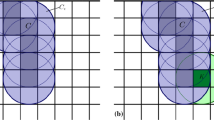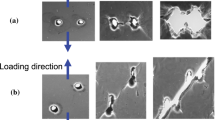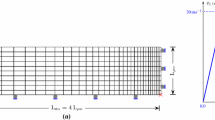Abstract
A method is proposed to model failure under shock loading. Finite Volume schemes are known to be efficient to take into account the density variations in the shock regions. The proposed method, called eXtended Finite Volume (XFV), is able to model failure in a finite volume framework. The material degradation is modeled using a cohesive zone model to dissipate the amount of energy required to create new surfaces. The XFV method allows to locate the cohesive surface inside elements and to introduce a displacement jump inside the cracked cells without remeshing, in an explicit dynamics finite volume framework. Attention is paid to the mass lumping and scheme stability. The XFV method is validated to simulate a plate impact experiment. It shows the ability to reproduce spall patterns and free surface velocities. However, numerical stability issues still need to be fixed before being able to compare the simulation with experimental data.

































Similar content being viewed by others
Notes
\(\sigma _{N0}\) depictes the cohesive traction projected on the cohesive surface, as a force per unit surface.
Cases A and E are limit cases respectively approaching a linear cohesive law and a Dugdale model. However, in the implementation of the cohesive model in Hesione code, it is not possible to choose \(\delta _1 = 0 \) or \(\delta _1 = \delta _{Nc}\). These values have therefore been approximated to get \(\delta _1 \approx 0 \) and \( \delta _1 \approx \delta _{Nc} \).
Once again, cases A and E are limit cases corresponding respectively to a linear cohesive law and a Dugdale model.
References
Roy G (2003) Vers une modélisation approfondie de l’endommagement ductile dynamique: investigation expérimentale d’une nuance de tantale et développements théoriques. PhD thesis, Poitiers
Besson J (2010) Continuum models of ductile fracture: a review. Int J Damage Mech 19(1):3–52
Johnson JN (1981) Dynamic fracture and spallation in ductile solids. J Appl Phys 52(4):2812–2825
Czarnota C, Jacques N, Mercier S, Molinari A (2008) Modelling of dynamic ductile fracture and application to the simulation of plate impact tests on tantalum. J Mech Phys Solids 56(4):1624–1650
Gurson AL (1977) Continuum theory of ductile rupture by void nucleation and growth: part 1—yield criteria and flow rules for porous ductile media. J Eng Mater Technol Trans ASME 99(1):2–15
Tvergaard V, Needleman A (1984) Analysis of the cup-cone fracture in a round tensile bar. Acta Metall 32(1):157–169
Bargellini R, Besson J, Lorentz E, Michel-Ponnelle S (2009) A non-local finite element based on volumetric strain gradient: application to ductile fracture. Comput Mater Sci 45(3):762–767
Ambati M, Gerasimov T, De Lorenzis L (2015) Phase-field modeling of ductile fracture. Comput Mech 55(5):1017–1040
Dugdale DS (1960) Yielding of steel sheets containing slits. J Mech Phys Solids 8(2):100–104
Needleman A (1987) A continuum model for void nucleation by inclusion debonding. J Appl Mech 54(3):525–531
Gullerud AS, Gao X, Dodds RH Jr, Haj-Ali R (2000) Simulation of ductile crack growth using computational cells: numerical aspects. Eng Fract Mech 66(1):65–92
Moës N, Stolz C, Bernard P-E, Chevaugeon N (2011) A level set based model for damage growth: the thick level set approach. Int J Numer Methods Eng 86(3):358–380
Stershic AJ, Dolbow JE, Moës N (2017) The thick level-set model for dynamic fragmentation. Eng Fract Mech 172:39–60
Zhang H, Li L, An X, Ma G (2010) Numerical analysis of 2-d crack propagation problems using the numerical manifold method. Eng Anal Bound Elem 34(1):41–50
Terada K, Asai M, Yamagishi M (2003) Finite cover method for linear and non-linear analyses of heterogeneous solids. Int J Numer Methods Eng 58(9):1321–1346
Moës N, Dolbow J, Belytschko T (1999) A finite element method for crack growth without remeshing. Int J Numer Methods Eng 46(1):131–150
Hansbo A, Hansbo P (2004) A finite element method for the simulation of strong and weak discontinuities in solid mechanics. Comput Methods Appl Mech Eng 193(33):3523–3540
Areias PM, Belytschko T (2006) A comment on the article “A finite element method for simulation of strong and weak discontinuities in solid mechanics” by a. hansbo and p. hansbo [comput. methods appl. mech. engrg. 193 (2004) 3523–3540]. Comput Methods Appl Mech Eng 195(9):1275–1276
Rozycki P, Moës N, Bechet E, Dubois C (2008) X-fem explicit dynamics for constant strain elements to alleviate mesh constraints on internal or external boundaries. Comput Methods Appl Mech Eng 197(5):349–363
Song J-H, Areias P, Belytschko T (2006) A method for dynamic crack and shear band propagation with phantom nodes. Int J Numer Methods Eng 67(6):868–893
Menouillard T, Rethore J, Combescure A, Bung H (2006) Efficient explicit time stepping for the extended finite element method (x-fem). Int J Numer Methods Eng 68(9):911–939
Elguedj T, Gravouil A, Maigre H (2009) An explicit dynamics extended finite element method. Part 1: mass lumping for arbitrary enrichment functions. Comput Methods Appl Mech Eng 198(30):2297–2317
Menouillard T, Rethore J, Moes N, Combescure A, Bung H (2008) Mass lumping strategies for x-fem explicit dynamics: application to crack propagation. Int J Numer Methods Eng 74(3):447–474
VonNeumann J, Richtmyer RD (1950) A method for the numerical calculation of hydrodynamic shocks. J Appl Phys 21(3):232–237
Wilkins M L (1963) Calculation of elastic-plastic flow. Technical report, California Univ Livermore Radiation Lab
Flament J, Perlat J-P (2011) Méthode de couplage euler-lagrange pour la dynamique rapide. In 10e colloque national en calcul des structures
Longère P, Dragon A (2013) Description of shear failure in ductile metals via back stress concept linked to damage-microporosity softening. Eng Fract Mech 98:92–108
Desgraz JC, Lascaux P (1976) Stabilite de la discretisation des equations de l’hydrodynamique lagrangienne 2d. Computing Methods in Applied Sciences. Springer, Berlin, pp 510–529
Grüneisen E (1912) Theorie des festen zustandes einatomiger elemente. Ann Phys 344(12):257–306
McQueen RG, Marsh SP, Taylor JW, Fritz JN, Carter WJ (1970) The equation of state of solids from shock wave studies. In: High velocity impact phenomena, vol 293, pp 293–417
Steinberg D, Cochran S, Guinan M (1980) A constitutive model for metals applicable at high-strain rate. J Appl Phys 51(3):1498–1504
Wilkins ML (1980) Use of artificial viscosity in multidimensional fluid dynamic calculations. J Comput Phys 36(3):281–303
Tvergaard V, Hutchinson JW (1992) The relation between crack growth resistance and fracture process parameters in elastic-plastic solids. J Mech Phys Solids 40(6):1377–1397
Scheider I (2009) Derivation of separation laws for cohesive models in the course of ductile fracture. Eng Fract Mech 76(10):1450–1459
Baranger J, Maitre J-F (1996) Connection between finite volume and mixed finite element methods. ESAIM Math Modell Numer Anal 30(4):445–465
Chan RK-C (1975) A generalized arbitrary Lagrangian–Eulerian method for incompressible flows with sharp interfaces. J Comput Phys 17(3):311–331
Buy F, Llorca F (2002) Shock wave effects in copper: design of an experimental device for post recovery mechanical testing. In: AIP conference proceedings, vol 620. AIP, pp 319–322
Courant R, Friedrichs K, Lewy H (1928) Über die partiellen differenzengleichungen der mathematischen physik. Math Ann 100(1):32–74
Author information
Authors and Affiliations
Corresponding author
Additional information
Publisher's Note
Springer Nature remains neutral with regard to jurisdictional claims in published maps and institutional affiliations.
Rights and permissions
About this article
Cite this article
Gorecki, M., Peillex, G., Pillon, L. et al. An enriched finite volume formulation for the simulation of ductile material failure under shock loading. Comput Mech 65, 1267–1288 (2020). https://doi.org/10.1007/s00466-020-01818-0
Received:
Accepted:
Published:
Issue Date:
DOI: https://doi.org/10.1007/s00466-020-01818-0




